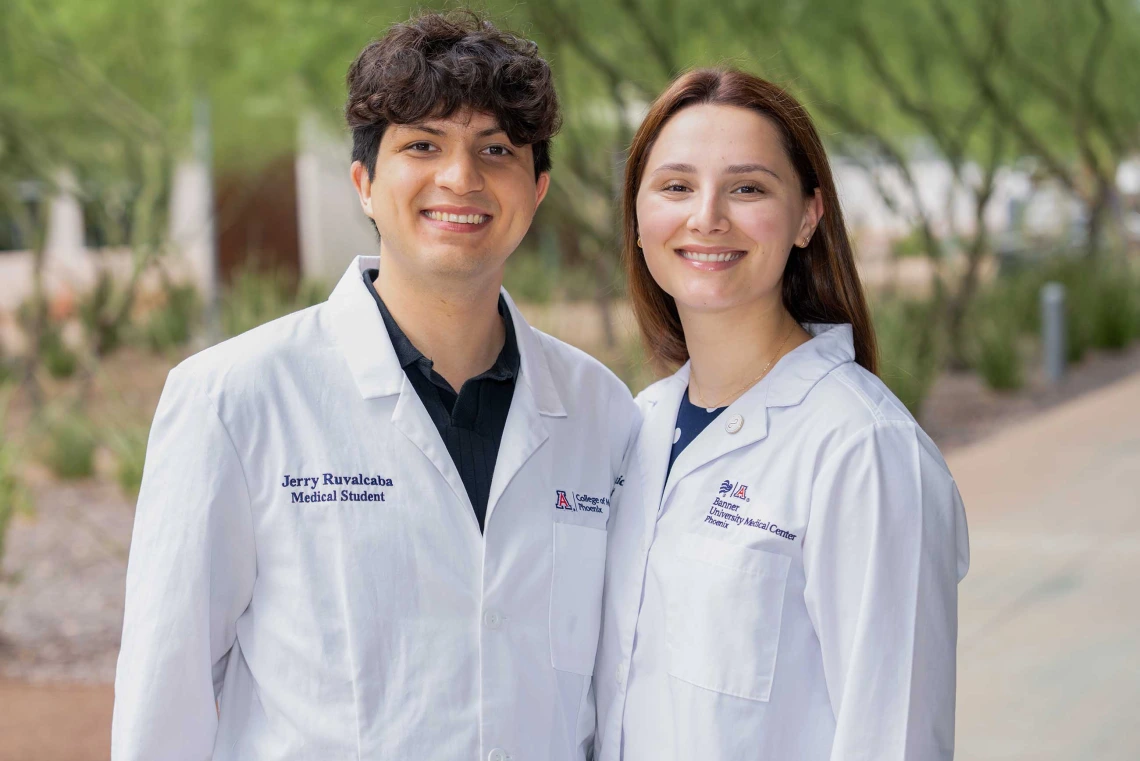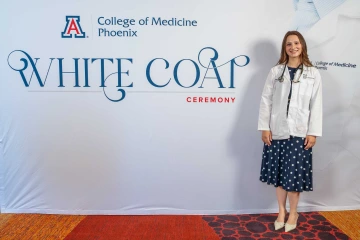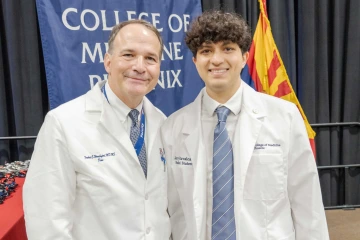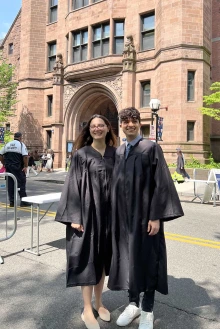Couple commits to caring for Phoenix together
Primary Care Physician Scholarship supports their joint mission to relieve the health care provider shortage in their new home.

Jerry Ruvalcaba and Katie Simic, both students in the Primary Care Physician Scholarship Program at the University of Arizona College of Medicine – Phoenix, are committed to practicing primary care together in Phoenix.
Photo by Adam Brooks, U of A College of Medicine – Phoenix
Jerry Ruvalcaba and Katie Simic lived only 15 miles apart in the Los Angeles area, never crossing paths until they met 3,000 miles from home as undergraduates. They quickly discovered a shared lifelong ambition to practice medicine.

Simic, a Primary Care Physician Scholarship recipient committed to a future as a pediatrician in the Phoenix area, stands in her white coat at the U of A College of Medicine – Phoenix White Coat Ceremony.
Photo courtesy of Katie Simic
Now, both are members of the Primary Care Physician Scholarship Program cohort at the University of Arizona College of Medicine – Phoenix. The scholarship covers costs for students who plan to ease the state’s urgent need for physicians.
They plan to marry before graduating.
“It’s been really amazing to pursue these futures side by side,” said Simic, who graduated from Yale University in 2023 with Ruvalcaba and began her first year at U of A College of Medicine – Phoenix in July.
Simic is studying to become a pediatrician and Ruvalcaba a family physician. The University of Arizona Health Sciences scholarship enables them to train for their careers without amassing debt.
Each scholarship recipient commits to practicing a primary care specialty in Arizona for two to four years after completing their residency. Simic and Ruvalcaba are eager to remain in Phoenix and help fill gaps in an urban region that includes many pockets designated as health professional shortage areas and medically underserved areas by the Health Resources and Services Administration.
During their past year living in the city, both have developed perspectives on its populations and medical needs. Simic worked as a child life assistant at Phoenix Children’s Hospital, and Ruvalcaba gained clinical experience while completing his first year of medical school.
Primary care rooted in community and continuity
Ruvalcaba’s motivation to serve stems from growing up in a medically underserved community in East Los Angeles.
“Going to the doctor for me was not an hourlong appointment,” he said. “It was a daylong thing because of how limited opportunities were to see a physician. It was just so crowded.”
Ruvalcaba also lacked continuity with a primary care physician, as they rotated quickly through his family’s medical clinic. Through these experiences, he formed clear intentions for the kind of family physician he will become.

Jerry Ruvalcaba (right), a student committed to becoming a family physician in Phoenix, is pictured with Fredric Wondisford, MD, dean of the University of Arizona College of Medicine – Phoenix.
Photo courtesy of Katie Simic
“I want to not only alleviate the shortage but also be that person who has a cultural connection with the patient population,” he said.
As a volunteer at downtown Phoenix’s Wesley Health Center, which primarily serves Hispanic people, Ruvalcaba enjoys taking the time to get to know patients and talking with them in Spanish, his first language. Ruvalcaba’s parents immigrated from Mexico before he was born.
“It feels like I’m talking to family when I’m in the clinic,” he said.
Ruvalcaba is improving his skills with help from the Advancing Medical Inclusivity: Growing Our Spanish Skills, or AMIGOSS, program, which teaches students to achieve Spanish fluency in discussing medical matters. He said he plans to serve Spanish-speaking patients as a fully bilingual provider.
“Having grown up with my parents mainly speaking Spanish and going to the hospital, I know it can be scary when you feel unheard,” he said.
Ruvalcaba said he also looks forward to building ongoing relationships. He’s observed the value of lasting relationships by working with Dr. Edward Perrin, MD, at Desert Ridge Family Physicians as part of the College of Medicine – Phoenix’s Combined Clinical Experience, or CCE, program.
“You should know your physician one on one,” Ruvalcaba said. “It makes it a lot more comfortable to talk about your problems.”
Perrin has become a mentor and demonstrated humility in a field that Ruvalcaba said requires “knowing a lot about a lot.”
“You go to medical school and study for so many years, but you can't know everything,” Ruvalcaba said.
Ruvalcaba said he also appreciates being part of the scholarship cohort, as the other students share his goals and financial considerations. The program is helping him and his fellow scholars take confident steps toward the futures they want to create.
“Primary care is a lower-income specialty,” he said. “If your medical school is already paid off, it eases the stress.”
A powerful role in pediatrics
Simic, the daughter of two emergency medicine physicians, never doubted what her vocation would be. However, when she completed her bachelor’s degree in molecular, cellular and developmental biology, she hadn’t chosen a medical specialty. She joined Teach for America, a nonprofit that places recent college graduates in underresourced schools.
Working as a middle school teacher in San Jose, California, Simic discovered a love for teaching children about science and health.

Simic and Ruvalcaba graduated together from Yale University and are now pursuing their MDs at the U of A College of Medicine – Phoenix, with plans to practice medicine and help alleviate the health care provider shortage in their new home.
Photo courtesy of Katie Simic
“I realized how amazing it was seeing students’ whole minds shift once they learned a new concept and became excited about science and asked more questions,” she said.
Simic also learned about barriers that can keep children from making the most of health care. This knowledge grew when she moved to Phoenix in 2024 and began working at Phoenix Children’s Hospital. As a child life assistant, she helped patients adjust to the hospital environment through therapeutic play or by providing a sympathetic ear. She served at-risk youths in both roles.
One young boy kept returning to the hospital every few weeks because he wasn’t following his diabetes treatment protocol. As a foster child, he didn’t have someone to consistently remind him to take medications. Nor did he have consistent primary care.
“And part of it was, he thought that if he didn't take his medications, maybe the diabetes would go away,” she said.
Experiences like these demonstrated to Simic that providers must meet patients and their families where they are, understanding that certain groups struggle more with health due to social determinants, such as a lack of housing and nutrition. And she discovered a way to continue teaching.
“The awesome thing about pediatrics is that you also have an opportunity to be an educator for your patients,” she said. “That's a powerful role — to follow a kid from birth until adulthood and to help them along that path of learning more about their health and slowly but surely becoming their own advocate.”
Simic said she was “ecstatic” to be admitted to the College of Medicine – Phoenix and receive the Primary Care Physician Scholarship.
She’s exploring joining student organizations, such as Street Medicine Phoenix, that will give her the chance to serve vulnerable patient populations over the next four years.
“I can now focus on this dream of pursuing pediatrics and working with at-risk people within the Phoenix area, which I've come to love,” she said. “I'm really excited to continue my work here.”

